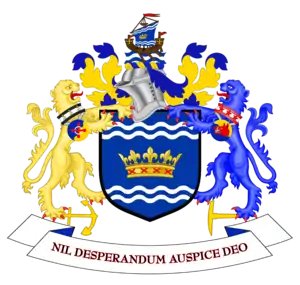Stadium of Light
The Stadium of Light is an all-seater football stadium in Sunderland, England and the eighth and current home to Sunderland A.F.C. With space for 49,000 spectators,[2] the Stadium of Light is the ninth largest stadium in England. The stadium primarily hosts Sunderland A.F.C. home matches. The stadium was named by chairman Bob Murray to reflect the coal mining heritage of the North East and the former Monkwearmouth Colliery site on which it stands.[3] A Davy lamp monument stands at the entrance to reflect the coal mining industry that brought prosperity to the town.[4]
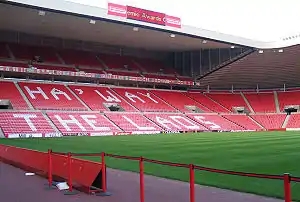 The North Stand of the Stadium | |
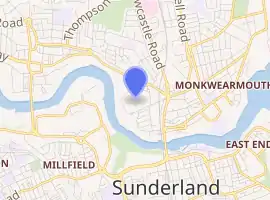
| |
| Full name | Stadium of Light |
|---|---|
| Location | Monkwearmouth, Sunderland |
| Coordinates | 54°54′52″N 1°23′18″W |
| Public transit | Stadium of Light Metro station, St Peters Metro station |
| Owner | Sunderland A.F.C. |
| Capacity | 49,000 – Association Football 49,000 – Music concerts |
| Record attendance | Football: 48,353 (Sunderland v Liverpool, 13 April 2002) Concerts: 54,259 (Diamonds World Tour, 20 June 2013) |
| Field size | 115 × 75 yards (105 × 68 metres) |
| Surface | Grass |
| Construction | |
| Broke ground | May 1996 |
| Opened | 1997 |
| Expanded | 2000 |
| Construction cost | £24 million[1] |
| Architect | PNF Architects |
| Main contractors | Ballast Wiltshire PLC |
| Tenants | |
| Sunderland A.F.C. (1997–present) | |
As well as hosting Sunderland games, the stadium has hosted three matches for the England national football team, as well as one England under-20 football team match. With an original capacity of 42,000, it was expanded in 2000 to seat 49,000. Its simple design is apparently to allow for redevelopments up to a capacity of 63,000.[5] The attendance record at the Stadium of Light is 48,353 set on 13 April 2002, when Sunderland played Liverpool with the visitors running out 1–0 winners. Along with hosting football matches, the stadium has played host to performers such as Beyoncé, Rihanna, Oasis, Take That, Kings of Leon, Coldplay and the Spice Girls. The ground also holds conference and banqueting suites, the Black Cats Bar, and a club shop selling Sunderland merchandise.
Planning and construction
Following the release of the Taylor Report in January 1990, Sunderland was obliged to make plans to turn their Roker Park home into an all-seater stadium.[6] Roker Park was a ground that mainly consisted of standing terraces, and if converted into all-seater it would have held far fewer spectators than before.[6] Enclosed by residential streets on all sides, expansion was practically impossible. So, by 1991, Sunderland chairman Bob Murray had started to scour the local area for possible sites to build a new all-seater stadium.[6]
The front-runner that emerged was a proposed stadium located on an area of land adjacent to the Nissan car plant.[7] The 49,000 all-seater ground was labelled "the Wembley of the North" by Sunderland fans and would boast a capacity that not even Manchester United's Old Trafford exceeded until 1996.[7] The plans did not come to fruition. Shortly after the plans were announced in 1992, Nissan launched an official objection, ultimately forcing Sunderland to abandon the idea.[7] By 1995, the site of the Wearmouth Colliery, which had closed in December 1993, was identified as the club's preferred location for a new stadium.[7] The area, on the north bank of the River Wear in the Sheepfolds district of Sunderland, was only a few hundred yards from Roker Park, and close to the centre of the city.
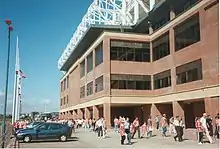
In 1993, Sunderland's planned new stadium was on the shortlist for Euro 96 venues, as England had been named as hosts of the competition in May 1992. However, it soon become clear that a new stadium in Sunderland would not be ready in time for the tournament.
On 13 November 1995, the Sunderland chairman Bob Murray announced that the Tyne and Wear Development Corporation had approved plans for Sunderland to build a 34,000-seater stadium on the Monkwearmouth site.[8] Ballast Wiltshier plc, a contracting company that had built the Amsterdam Arena, was contracted to build the stadium at an initial cost of £15 million.[8] In June 1996, as the planned capacity rose to more than 40,000, construction work began.[8] The capacity was revised again in early 1997, and the stadium was completed on time, with a capacity of 42,000.[8] The stadium's design allows possible expansion of a further tier; completed expansion of the whole upper tier would produce a capacity of 63,000, although it is believed by some that the stadium can expand to a maximum capacity of 84,000, this would seem unlikely ever to be exercised.[5]
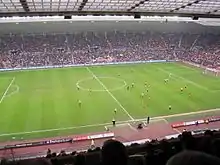
The stadium was opened on 30 July 1997 by Prince Andrew, Duke of York, with bands such as Status Quo, Upside Down and Kavana playing. To celebrate the opening of the stadium, Sunderland played a friendly against the Dutch side Ajax, which was drawn 0–0.[8]
The move did not happen without criticism. Famous actor and Sunderland supporter, often named in the media "Sunderland's most famous supporter",[9] Peter O'Toole, said he wasn't as much a fan as he used to be since the team left Roker Park.[10][11] Playwright Tom Kelly and actor Paul Dunn created a one-man play called "I Left My Heart at Roker Park" about a fan struggling with the move and what Roker Park meant for him - the play originally ran in 1997, and had a few revivals since.[12][13][14]
The North Stand was extended in 2000 to bring the capacity to 49,000, costing the club a further £7 million, making the final cost of the stadium £23 million.[5] On 18 July 2006, a statue of 1973 FA Cup Final winning manager Bob Stokoe was unveiled outside the stadium.[15] At the end of season Football League awards, the Stadium of Light was named the Best Away Ground, with other contenders including Crewe Alexandra's Alexandra Stadium and Plymouth Argyle's Home Park.[16] Sunderland celebrated the tenth anniversary of the stadium with a pre-season friendly against Juventus on 6 August 2007; the game was drawn 1–1.[17]
Name
During construction, the stadium had not adopted an official name, and had been known colloquially as the "Wearside Stadium" and "New Roker Park".[18]
The name was eventually revealed as the Stadium of Light at a naming ceremony on 30 July 1997, hours before the opening game against Ajax.[19] Speaking at the naming event, Bob Murray explained the inspiration for the name came from the Coal mining heritage of the region and the stadium's Monkwearmouth Colliery site:
"For many years, miners at Wearmouth Colliery carried with them a Davy lamp as part of their working lives. Reflecting this tradition, the name allows the image of this light to shine forever."
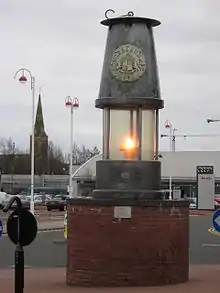
To emphasise the fact, a statue of a miner's Davy lamp was located in front of the stadium's ticket office, adjacent to the stadium.[18]
The name initially drew mixed reactions from Sunderland fans many unhappy that the name was already associated with the home ground of S.L. Benfica.[20][21] A film crew for the Premier Passions documentary series, recorded the moment that Bob Murray faced Sunderland fans immediately after the naming with many expressing their disappointment. The similarity to the name of Benfica's home, Estádio da Luz, often anglicised to The Stadium of Light, has led to some visiting fans and reporters to erroneously assume that Sunderland's home was named after the Portuguese stadium.[22][23] Murray responded directly to this in a 2017 interview with the Evening Chronicle, in which he said
"The Estadio de Luz in Portugal isn’t the Stadium of Light, it is named after the area – Luz. It’s like, say, Elland Road or Old Trafford. We are the only club whose stadium has that name, and it was because of the history of the region that I named it".[3]
In the same interview, Murray revealed that shortly after the stadium opened he was approached by a representative of the Labour government asking if he would consider renaming the stadium after Diana, Princess of Wales, who died in September 1997.[3] Murray refused the request as he believed the stadium should be named in honour of those in the region who had worked in darkness.
The 'Of Light' suffix became a recognisable part of the Sunderland A.F.C. brand, and was used in a number of other areas related to the club; the Academy of Light is the club's training facility and youth academy, the Foundation of Light is a registered charity affiliated with the club and the Beacon of Light is a sports and education centre, owned by the Foundation, which is adjacent to the stadium. The club's official magazine was called Legion of Light before it was discontinued in January 2017.
In March 2010, Sunderland Chairman Niall Quinn announced the club were considering plans to sell naming rights to the stadium as a new way to boost income.[20] The plans were shelved shortly after. The possibility of selling the naming rights was floated again by chief executive Margaret Byrne in 2013.[24] Discussing the options of selling the stadium name in October 2018, chairman Stewart Donald said:
"I think the fans should have a say on whether they are comfortable with it. My gut feel is that even if we didn't consult with them, the vibe I get is that they aren't particularly attached to the name of the stadium. It's not a sacred thing like some of the other grounds."[25]
Structure and facilities
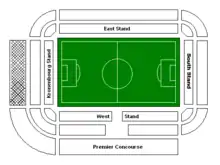
The stadium is in the shape of a square bowl, and is separated into the West Stand, North Stand, East Stand and the Roker End (South Stand). The stands have all formerly had commercial names as part of sponsorship deals, e.g. the Vaux Stand (West), the Carling Stand (North), Fosters Stand (East) and the Metro FM Stand (South).[26] The South Stand was renamed to the Roker End in December 2018, following a poll organised by the Red & White Army supporters club.[27] The Roker End was the name of the stand behind the goal at the southern end of the ground at Roker Park.[28]
The West Stand includes the Premier Concourse which is the name of the upper tier[29] and a number of executive boxes.[30] The North Stand also includes an upper tier, formerly branded the Strongbow Upper, which contained the exterior seating for the Black Cats Bar, an enhanced match-day experience with padded seating and an exclusive catering facilities and bar. When the away fans were relocated in 2012, the Black Cats Bar seating was relocated to the rear of the North Stand lower tier.[31]
Within the stadium is a concourse, housing the turnstiles, emergency exits, food kiosks, bars and toilet facilities. The concourse allows uninterrupted spectator access throughout the inner stadium bowl, with the exception being a gap between the South Stand and the South West corner. The concourse is linked to the seating bowl via a series of access ramps. The South East corner of the stadium is designated as the Family Zone,[32] and has family-oriented branding within the concourse, as well as entertainment such as PlayStation 4 consoles.
Away fans were seated in the west half of the South Stand when the ground opened in 1997, but in November 2011, the club announced that the away supporters' section would be moved from the South Stand to the North Stand Upper from the beginning of the 2012–13 season.[33][34]
The pitch is several metres below the level of the ground outside the stadium.[35] The pitch uses a lighting system from Stadium Grow Lighting to ensure the grass can grow at any time of year. The device controls various aspects of the pitch, including exposure to light, temperature, water, and air, to make the grass able to grow in any conditions.[36]

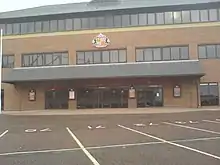
To the North East of the stadium stands the Black Cat House, a separate building which is the location of the Box office and club administrative offices. There is a large car park behind the West Stand and two car parks behind the East Stand, but match-day parking is permit only.[37] Fragments of the iconic Archibald Leitch latticework, taken from the Main Stand at Roker Park, is used to separate parts of the Western Car Park.[38] Wooden boards mimicking the Leitch lattice work were also added to the Roker End in 2019 as part of an initiative by the Red & White Army supporters group to bring a sense of identity to renamed stand.[39]
The perimeter walls of the stadium incorporate a "Wall of Fame" feature, where names can be engraved into the bricks of the walls.[40] The interior of the stadium holds a banqueting suite, which can seat from 460 to 600 people.[41] The stadium also contains several conferencing suites, that can be hired for events.[42] Quinn's Bar, housed in the West Stand, was named after former player and chairman Niall Quinn and includes memorabilia from the club's history.[43] Originally it was available for non-match-day visitors, but has since become exclusive for match-day hospitality and event packages.
In 2004,The Centre for Light was opened by the SAFC Foundation within the Stadium. The £1.6m learning facility, built over multiple floors, included five learning areas supporting up to 120 visiting children per day.[44] In 2015, Sunderland became the first football club in the world to open a sensory room within the Stadium - thereby allowing people on the Autism spectrum to watch matches in a sound-proofed environment.[45] It was named the Nathan Shippey Sensory Room after Nathan's parents petitioned the club to set the room up.[46] The sensory room provided a huge success, with the model being adopted at other clubs around the world. Sunderland opened their second sensory room in 2018.[45]
In March 2018 it was announced that after the relegation to EFL League One, the Premier Concourse would be closed during the 2018–19 season,[47] although it was temporarily reopened to accommodate a large crowd for the Boxing Day game against Bradford City[48] and again on the final home league game against Portsmouth.
Seats
The stadium was originally kitted predominately with red seats, the exception being a Sunderland emblem and the words "SUNDERLAND A.F.C" in white lettering on the East Stand, and the slogan "HA'WAY THE LADS" ("Ha'way" is a Mackem dialect equivalent of the Geordie word "Howay", meaning "Come on"[49]) in white lettering on the North Stand. A thin band of white seats also circled the top of the East and South stand.

Over time, sections of red seats become bleached by the Sun, turning them pink - which became a source of mockery from opposing fans.[50] Sunderland fans petitioned the club to replace the seats, even noting on the inclusion of the faded pink seats in the digital replica of the Stadium of Light in the FIFA video game.[51] In 2016, the club announced that a programme of seat changes would take place as part of a face-lift for the stadium's 20th anniversary.[52] Sections of the East Stand were replaced, but further work stalled.
When Stewart Donald purchased the club in the summer of 2018, frustration over the pink seats (and the general state of the Stadium) came up frequently in his early engagements with fans. In June, Donald announced that he had purchased 31,500 seats and requested Sunderland fans to volunteer to help change them.[53] The seat change took place in phases, with hundreds of volunteering fans joined occasionally by club officials and players. Phase I was the South East corner and was completed on 19 July 2018,[54] Phase II was the North East corner and North Stand on was completed on 15 September 2018,[55] and Phase III the South West corner completed in October 2018. The fourth and final phase, replacing 10,000 seats in the South and West stands, began on 29 October 2018.[56] The corners were replaced with white seats, while the sides and ends were left red. The emblem and lettering remained. The club were nominated as a finalist in 'Best Club Marketing Initiative' category at the 2018 Business Football Awards for the seat change activity.[57]
Fan Zone
A 6,000 capacity Fan Zone, modeled on similar schemes at Manchester City and those at NFL games in the United States, was approved by Sunderland City Council in July 2015.[58] It followed a successful trial prior to a game against West Ham United in January 2013.[59]
It was opened on the first home game of the 2015–16 season. The zone was located in the car park outside the East Stand and South East corner, and included live music, children's activities (including a Five-a-side football pitch), food and drink kiosks and on-stage interviews with club legends.[60] The Fan Zone opened three hours before kick-off and for a few hours after the game, and was accessible to ticket-holding spectators, including away fans.[59] Due to the temporary structures in use, the Fan Zone was closed for safety reasons during periods of high winds.[61] An enhanced version of the Fan Zone was opened for the England senior international game vs Australia in 2016.[62]
The Fan Zone re-opened for the 2016–17 season opener against Middlesbrough,[60] but as the season progressed, poor performance on the field and financial troubles off the field led to the Fan Zone being cancelled.
In a Q&A with supporters association 'Red & White Army', new club owner Stewart Donald committed to bring back the Fan Zone.[63] It returned for the opening game of the 2018–19 season against Charlton Athletic, although smaller than the 2015 version, it was open to anyone - not just ticket-holding spectators. The Fan Zone no longer re-opens after a game.
Stadium Village
A 30 hectare site area around the Stadium, including the Sheepfolds Industrial estate, was designated as the 'Stadium Village' development zone by Sunderland City Council in 2007 - and a draft Supplementary planning document was released in 2009.[64] The plan, adopted in 2010, described a framework for redeveloping the Stadium Village area into a mixture of commercial, residential and entertainment facilities with a focus on health and well-being . The plan was consistent with wider redevelopment plans across Sunderland, then under the umbrella of Sunderland Arc agency. In preparation for the redevelopment plans, the council began buying up plots in the area in 2008.[65]
Initial redevelopment work focused on the Northern end of the site, adjacent to the stadium's North Stand and the Black Cat House ticket office. The buildings in this area have Stadium Park as their address. The Sunderland Aquatic Centre, including an Olympic-sized swimming pool and fitness centre, opened in April 2008.[66] In December 2014 construction work began on a new 141-room Hilton Garden Inn[67] which opened on 28 April 2016.[68][69] The Beacon of Light, a sports, education and community centre, opened in the summer of 2018 alongside the Aquatic Centre.[70]
In 2009, during a review of the Stadium Village plans, city councilors expressed ambitions to build an Indoor skiing facility on the site and an expression of interest was issued to potential developers.[71][72]
In the spring of 2011, the Sunderland Arc redevelopment agency was shut down, after its funding was pulled due to austerity cuts.[73] This put the long-term future of the Stadium Village plan in doubt. However the council partnered with IDPartnership Group to push ahead with the plan,[74] and in September 2017, a 'masterplan' for Phase II of the Stadium Village area was approved by Sunderland council and released for public consultation.[75] The Phase II area covers an area to the South and East of the stadium and proposals included facilities such as a Velodrome, an Ice rink, a Conference centre and a Climbing wall.[76]
A key part of the new masterplan is Stadium Way, a proposed tree-lined boulevard linking the St Peter's Metro station with a proposed Plaza at the South East corner of the stadium.[77] The plaza would incorporate an enhanced Fan Zone, and is modelled on a similar space being developed as part of the Tottenham Hotspur Stadium in London.[78]
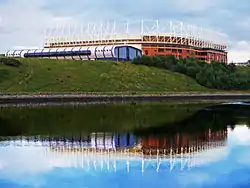
International matches
As well as holding Sunderland games, the stadium has also hosted England matches. The stadium was one of several venues used as temporary home grounds for the England team while the redevelopment of Wembley Stadium took place.[79] It hosted its first England game in 1999, when they played Belgium in a friendly match, which England won 2–1.[80] It played host to its first competitive England match on 2 April 2003, when they played Turkey in a Euro 2004 qualifying match, which England won 2–0.[81] The Stadium of Light also held an England under 20 match against Italy on 27 November 2002, Italy beat England 5–3.[82] On 10 June 2003 it hosted England's under-21s 2004 UEFA European Under-21 Championship qualification Group 7 match against Slovakia's under-21s. The hosts beat the visitors 2–0 through Peter Doležaj's fortieth minute own goal and Phil Jagielka's eighty third-minute goal with 11,223 in attendance.
On 4 March 2016 it was announced that the Stadium of Light would host England for a friendly against Australia on 27 May 2016 as part of their preparations for Euro 2016.[83] The sold-out match finished in a 2–1 victory for England, with goals from Marcus Rashford (on his international debut), Wayne Rooney and an own goal from Eric Dier.[84]
Matches
| 10 October 1999 Friendly | England | 2–1 | | Sunderland |
| 15:00 BST | Alan Shearer Jamie Redknapp |
Branko Strupar |
Stadium: Stadium of Light Attendance: 40,897 Referee: Anders Frisk Sweden |
| 27 November 2002 Under 20 International | England | 3–5 | | Sunderland |
| 20:00 GMT | Michael Chopra Darren Carter |
Felice Piccolo Fabio Quagliarella Emanuele Calaiò Marco Donadel |
Stadium: Stadium of Light Attendance: 6,544 Referee: Jürgen Jansen Germany |
| 2 April 2003 UEFA Euro 2004 Qualifying | England | 2–0 | | Sunderland |
| 20:00 BST | Darius Vassell David Beckham |
Stadium: Stadium of Light Attendance: 47,667 Referee: Urs Meier Switzerland |
| 10 June 2003 2004 UEFA U-21 Group 7 Qualifier | England | 2–0 | | Sunderland |
| 20:00 BST | Peter Doleza (OG) Phil Jagielka |
Stadium: Stadium of Light Attendance: 11,223 Referee: Tommy Skjerven Norway |
| 27 May 2016 Friendly | England | 2–1 | | Sunderland |
| 20:00 BST | Marcus Rashford Wayne Rooney |
Eric Dier |
Attendance: 46,595 Referee: Danny Makkelie Netherlands |
Other uses
Concerts
| Summer | Artist |
|---|---|
| 2009 | Oasis,[85] Take That[86] |
| 2010 | Pink[87] |
| 2011 | Take That,[88] Kings of Leon[89] |
| 2012 | Red Hot Chili Peppers,[90] Coldplay,[91] Bruce Springsteen and the E Street Band [92] |
| 2013 | Bon Jovi, Rihanna, North East Live [93] |
| 2014 | One Direction, North East Live [93] |
| 2015 | Foo Fighters [94] |
| 2016 | Beyoncé [93] |
| 2019 | Spice Girls and Jess Glynne,[95][96] |
In October 2008 it was announced that the stadium would hold a concert on 10 June 2009, featuring Oasis, with Kasabian, The Enemy and Reverend and the Makers as support acts.[85]
On 5 and 6 June 2009 Take That started their nationwide 'Circus' tour at the Stadium of Light.[86] Pink performed a sell out show at the stadium on 11 June 2010, with support from VV Brown, Butch Walker and City & Colour.[87]
Take That returned to the stadium along with Robbie Williams on 27 May 2011, supported by Pet Shop Boys. On this occasion Take That began their Progress Live tour in Sunderland, making the Stadium of Light the first venue to hear Take That perform as a five since 1995. Originally only two dates were announced, however due to huge demand from fans two further dates were added at the Stadium of Light.[88]
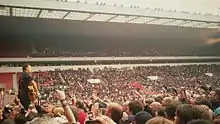
Kings of Leon played at the stadium on 17 June 2011 as part of their nationwide tour across Britain.[89] During the summer of 2012, Bruce Springsteen and the E Street Band, Coldplay and the Red Hot Chili Peppers performed at the stadium. On 30 October 2012, it was announced that Bon Jovi would play at the stadium during the summer of 2013.
On 20 June 2013 Rihanna performed a sold-out show at the stadium as part of the European leg of her Diamonds World Tour. Rihanna was scheduled to return to the stadium during her Anti World Tour, but the concert was cancelled.[97] 2013 also saw the stadium hold the first of two 'North East Live' concerts, a music festival featuring artists such as Little Mix and Jessie J.[98]
After the 2016 concert by Beyoncé as part of her Formation World Tour there was a three-year hiatus for concerts at the Stadium of Light after Sunderland City Council withdrew their financial support.[99] Following the takeover of the club in 2018, new Executive director Charlie Methven confirmed that concerts would return in the summer of 2019.[96] On 5 November 2018, the Spice Girls announced their 2019 Spice World Tour, with Jess Glynne as a support act. The UK leg of the tour included a concert at the Stadium of Light on 6 June 2019.[95]
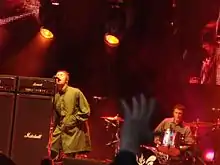
Concert Capacity
The exact capacity of the stadium for concerts varies depending on the profile of the act and the layout of the stage. Sunderland city council capped the original 2009 concerts to 51,528 for Take That and 52,933 for Oasis.[100] The 2010 Pink concert had a lower capacity of 42,054.[101] The 2015 Foo Fighters concert had a capacity of 56,351.[102] The biggest ever capacity was for Rihanna's 2013 concert, which was granted a safety certificate for a crowd of 57,556, while the lowest was the North East Live concert a day later, capped at 31,726.[103] Box office records indicate that there were 54,259 tickets sold for the Rihanna concert which makes it the biggest attended event in the Stadium's history.[104] The Beyonce concert in 2016 had a capacity capped at 55,000[105] and the 2019 Spice Girls concert had a cap of 50,835.[106]
Sunderland University
The Stadium of Light currently hosts the annual graduation ceremony for the students of the University of Sunderland.[107] The stadium won the RSVP magazine's Most creative use of a sporting venue award in 2007 for its usage as the university's graduation site.[108]
Records
Attendances
The highest football attendance at the Stadium of Light is 48,353 set on 13 April 2002 for a Premier League game between Sunderland and Liverpool. The Stadium attendance record for non-football is 54,529 on 20 June 2013 for a Rihanna concert.[104]
The lowest league attendance at the stadium was 22,167 against Wigan Athletic on 2 December 2003.[109] The lowest attendance for a first-team competitive game at the Stadium of Light was 6,952 against Grimsby Town in the leasing.com Trophy Group Stage on 8 October 2019. Sunderland won the match 3–2.[110]
The highest seasonal average at the stadium since it was opened was 46,790 in the 2000–01 season while Sunderland were playing in the Premier League.[111] The lowest average attendance at the Stadium of Light was 27,119 in the 2003–04 season in Division One.[112] The highest total seasonal attendance was recorded during the 1998–99 season when the aggregate was 890,660 in a season where Sunderland were First Division champions, and League Cup semi-finalists.[113] The lowest seasonal aggregate at the Stadium of Light was 623,741 in the 2003–04 season, the same season that the club were FA Cup and play off semi-finalists.[112]
In the 2018-19 season, Sunderland averaged a home league crowd of 32,156, setting a new record for the third tier, while the Boxing Day game against Bradford City attracted 46,039, both a League One record, and the highest attended league game outside of the Premier League that season.[114]
Results
Sunderland's largest margin of victory at the stadium was a 7–0 win over Oxford United in Division 1 during the 1998–99 promotion season.
Sunderland's biggest defeat at the Stadium of Light was 5–0 in a preseason friendly (marking the 20th anniversary of the stadium) against Celtic on 29 July 2017.[115] Sunderland's biggest league defeat at the Stadium of Light is 4-0 which has happened on four occasions (all in the Premier League): vs. Arsenal (11 May 2003), vs. Manchester United (26 December 2007), vs. Aston Villa (14 March 2015) and vs. Southampton (11 February 2017).
The highest scoring match at the Stadium of Light was a 6-3 Sunderland victory over Exeter City in Round 2 of the EFL Cup on 25 August 2015.
Transport
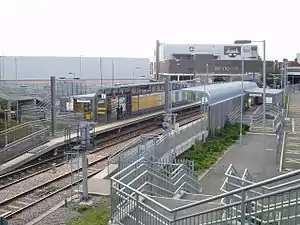
Sunderland railway station, which is connected to London King's Cross by infrequent services run by the Open Access operator Grand Central or by main line services run by London North Eastern Railway connecting via Newcastle or Darlington, is located nearby to the stadium.[116] The St Peter's and Stadium of Light Metro stations were built as part of the Sunderland extension, both are quite near the stadium, though ironically St. Peter's is a closer station to the ground than the Stadium of Light station. The Metro was extended into Sunderland in 2002.[117] A park and ride system is available on match days to allow spectators to park away from the stadium,[118] and a new footbridge proposal has been put forward to link the stadium to the south bank of the river as part of the stadium park regeneration project.[119]
References
General
- Days, Paul; John Hudson; John Hudson; Bernard Callaghan (1 December 1999). Sunderland AFC: The Official History 1879–2000. Business Education Publishers Ltd. p. 336. ISBN 978-0-9536984-1-7.
Specific
- "Away Grounds » Sunderland – Stadium of Light".
- "About the Stadium of Light". Sunderland A.F.C. Retrieved 13 May 2015.
- Hunter, James (24 July 2017). "The Princess Diana Stadium? Sir Bob Murray reveals request to rename the Stadium of Light". nechronicle. Retrieved 15 October 2018.
- Days, Paul; John Hudson; John Hudson; Bernard Callaghan (1 December 1999). Sunderland AFC: The Official History 1879–2000. Business Education Publishers Ltd. p. 302. ISBN 978-0-9536984-1-7.
- Days, p303
- Days, pp297-298.
- Days, pp299-300
- Days, p301
- Terry |, Paper (23 December 2013). "Peter O'Toole Dies - Sunderland Most Famous Supporter Is Dead". Wearside Online. Retrieved 13 May 2020.
- https://bleacherreport.com/articles/855822#slide0
- Randall, Colin (14 September 2010). "Peter O'Toole and a lost Sunderland passion". Retrieved 12 January 2020.
- Gav1879 (11 August 2014). "I Left My Heart in Roker Park". Roker Report. Retrieved 13 May 2020.
- "Theatre review: I Left My Heart in Roker Park... (And Extra Time at the Stadium of Light) at Customs House, South Shields". British Theatre Guide. Retrieved 13 May 2020.
- "Share your Stadium of Light tales". www.sunderlandecho.com. Retrieved 13 May 2020.
- Alexander, Nick (18 July 2006). "Stokoe statue unveiled". Sunderland A.F.C. Retrieved 6 December 2008.
- Alexandra, Nick (5 March 2007). "SoL voted best away ground". Sunderland A.F.C. Retrieved 6 December 2008.
- Taylor, Louise (6 August 2007). "Keane eyes Mido and Gordon as Ranieri backs Black Cats to surprise". The Guardian. London. Retrieved 6 December 2007.
- Days, p302
- "1997: Goodbye to Roker Park". Retrieved 15 October 2018.
- "Sunderland could sell stadium name". Retrieved 15 October 2018.
- "What happens next when a team moves stadium? Every new ground since 1988 assessed". The Telegraph. 2017. ISSN 0307-1235. Retrieved 15 October 2018.
- "Wembley sends for Bob the builder". Evening Standard. Retrieved 15 October 2018.
- baverstock, Neil (2007). Back in the Game. Lulu Enterprises, UK Ltd. p. 69. ISBN 978-1847532886.
- Douglas, Mark (2 March 2013). "Sunderland would consider new Stadium name". journallive. Retrieved 7 November 2018.
- "Stewart Donald reveals talks over renaming Sunderland's Stadium of Light". Retrieved 7 November 2018.
- "2008/09 Matchday Prices". Sunderland A.F.C. Retrieved 6 December 2008.
- "The Roker End: Sunderland rename Stadium of Light's South Stand". 14 December 2018. Retrieved 21 January 2019.
- Mason, Rob (18 December 2018). "Memories of a Roker Ender - as the famous name returns to the Stadium of Light". nechronicle. Retrieved 21 January 2019.
- "Mothballed Seats". Newcastle Chronicle. Retrieved 23 April 2018.
- "Executive Boxes". Sunderland A.F.C. Retrieved 6 December 2008.
- "Black Cats Bar". Sunderland A.F.C. Retrieved 6 December 2008.
- "Family Zone". Sunderland Association Football Club. Retrieved 17 October 2018.
- David Allison (8 November 2011). "Away fans headiS north at the Sunderland Stadium of Light". Sunderland Echo. Retrieved 5 December 2011.
- "Away Fans". Sky Tyne and Wear. Archived from the original on 24 June 2013. Retrieved 12 February 2012.
- "SoL 10th anniversary". Sunderland A.F.C. Retrieved 6 December 2008.
- "The Pitch". Sunderland A.F.C. Retrieved 6 December 2008.
- "Stadium of Light CPMS - Sunderland City Council". www.sunderland.gov.uk. Retrieved 17 October 2018.
- "The story behind the SoL". Sunderland Association Football Club. 19 July 2017. Retrieved 17 October 2018.
- Gav1879 (17 April 2019). "Roker Park latticework makes a comeback - and MORE flags ordered in time for Sunderland v Donny". Roker Report. Retrieved 10 May 2019.
- "SAFC Wall of Fame". Sunderland A.F.C. Retrieved 6 December 2008.
- "Banqueting Suite". Sunderland A.F.C. Retrieved 6 December 2008.
- "Suite Specifications". Sunderland A.F.C. Archived from the original on 17 October 2018. Retrieved 6 December 2008.
- "Stadium of Light bar named after Niall Quinn". Retrieved 17 October 2018.
- "A bit of class at the Stadium of Light". Retrieved 7 November 2018.
- "Inside Sunderland sensory room bringing game to life for autistic fans". The Independent. Retrieved 7 November 2018.
- "Sunderland's sensory room for autistic fans lauded as 'absolutely incredible'". Eurosport UK. 4 February 2016. Retrieved 7 November 2018.
- "About the Upper tiers being removed". BBC. Retrieved 9 March 2018.
- Rayner, Stuart (17 December 2018). "Stadium of Light's Premier Concourse to re-open". nechronicle. Retrieved 21 January 2019.
- "howay | Definition of howay in English by Oxford Dictionaries". Oxford Dictionaries | English. Retrieved 16 October 2018.
- "The pink seats are going at Sunderland's Stadium of Light – is it time Newcastle gave St James's Park a facelift?". Retrieved 17 October 2018.
- "Sunderland fan starts campaign to replace 'pink' seats at Stadium of Light". Retrieved 17 October 2018.
- "Sunderland AFC to replace 'pink' seats as Stadium of Light undergoes 20th anniversary face-lift". Retrieved 17 October 2018.
- "Stewart Donald confirms that Sunderland are set to replace pink seats at the Stadium of Light". Retrieved 17 October 2018.
- Rayner, Stuart (19 July 2018). "Phase one of Stadium of Light face-lift complete". nechronicle. Retrieved 17 October 2018.
- "Sign up to lend a hand this October". Sunderland Association Football Club. 8 October 2018. Retrieved 17 October 2018.
- "Here's how Sunderland AFC fans can help fit 10,000 seats in final phase of Stadium of Light revamp". Retrieved 5 November 2018.
- "Big Seat Change recognised". Sunderland Association Football Club. 27 September 2018. Retrieved 17 October 2018.
- "Sunderland councillors back plan for new 6,000 fan zone at Stadium of Light".
- "Fan zone ahead of football". Retrieved 17 October 2018.
- "What's new in the Sunderland AFC Fan Zone this season?". Retrieved 17 October 2018.
- "Sunderland AFC shut fanzone due to Storm Frank: Frankie and the Heartstrings gig cancelled". Retrieved 17 October 2018.
- Jeffery, Sarah (24 May 2016). "Stadium of Light opens enhanced fan zone for England game". nechronicle. Retrieved 17 October 2018.
- "NEWS: Sunderland looking at re-naming stands, whilst the FanZone will re-open for Charlton game". Roker Report. Retrieved 17 October 2018.
- "Stadium Village Development Framework - data.gov.uk". data.gov.uk. Retrieved 16 October 2018.
- "Sporting village progress goes on". Retrieved 17 October 2018.
- "City's £20m swimming pool opening". 17 March 2008. Retrieved 17 October 2018.
- "Sunderland Hotels - Hilton Garden Inn Sunderland".
- "Hilton Garden Inn Shines in Sunderland - Hilton Garden Inn Media Center".
- "Work starts on Sunderland's new Hilton Hotel".
- "First look inside Sunderland's Beacon of Light as £20million centre gets ready for opening". Retrieved 16 October 2018.
- "Plan for real-snow ski slope unveiled". The Northern Echo. Retrieved 16 October 2018.
- "Developer sought for new ski dome". 2010. Retrieved 17 October 2018.
- "The 17-year saga of Sunderland's Vaux site". Retrieved 17 October 2018.
- "Stadium Village | IDPartnership". IDPartnership. 29 September 2017. Retrieved 17 October 2018.
- "Ground-breaking vision for Sunderland's Stadium Village reach next stage". Retrieved 16 October 2018.
- "Ice arena, velodrome, climbing wall and hotels in masterplan for Stadium Village in Sunderland". Retrieved 16 October 2018.
- pg 81-83 - Stadium Village Masterplan - Draft Supplementary Planning Document, Sunderland City Council, December 2017
- Pg 78-80, Stadium Village Masterplan - Draft Supplementary Planning Document, Sunderland City Council, December 2017
- Paul Fletcher (29 May 2007). "End of the road for England". BBC Sport. Retrieved 29 May 2007.
- "England 2 Belgium 1". England Football Online. Retrieved 6 December 2008.
- "England surge past Turkey". BBC Sport. 2 April 2003. Retrieved 6 December 2008.
- Wright, James (27 November 2002). "Under-20s given the Chop by Italy". The FA. Archived from the original on 8 April 2005. Retrieved 6 December 2008.
- Association, The Football. "England to play in Manchester and Sunderland as part of Euro 2016 preparation - England - The FA".
- Light, Phil McNulty Chief football writer at the Stadium of. "England 2-1 Australia".
- "Oasis to play Stadium of Light". Sunderland Echo. 16 October 2008. Retrieved 6 December 2008.
- Carruthers, Marissa (28 October 2008). "Take That to play Stadium of Light". Sunderland Echo. Retrieved 6 December 2008.
- "Pink announces support acts". Sunderland A.F.C. 31 March 2010. Retrieved 2 November 2010.
- "Take That announce second Stadium of Light gig". Sunderland Echo. 29 October 2010. Retrieved 2 November 2010.
- Gordon Barr (29 October 2010). "Announced: Kings of Leon, Stadium of Light". The Evening Chronicle. Retrieved 7 November 2010.
- "Red Hot Chili Peppers announce Stadium of Light concert". The Northern Echo. 1 November 2011. Retrieved 1 November 2011.
- "Sunderland Stadium of Light goes from Red Hot to Coldplay". Sunderland Echo. 11 November 2011. Retrieved 11 November 2011.
- Bruce Unwin (21 November 2011). "Bruce Springsteen signs up for Sunderland stadium show". The Northern Echo. Retrieved 24 November 2011.
- "New Sunderland AFC owners 'absolutely intent' on return of Stadium of Light concerts". Retrieved 5 November 2018.
- "404".
- "Spice Girls to play Sunderland as part of reunion tour". The Northern Echo. Retrieved 5 November 2018.
- "Major music concerts to return to Stadium of Light next summer, says Sunderland AFC director Charlie Methven". Retrieved 31 October 2018.
- Bannister, Antonia (19 February 2016). "Rihanna postpones Anti tour - with Coventry gig put back 11 days".
- "North East Live set to return to Sunderland - NewcastleGateshead". www.newcastlegateshead.com. Retrieved 31 October 2018.
- "No gigs expected at the Stadium of Light this summer". Retrieved 31 October 2018.
- "Document not found". www.sunderland.gov.uk. Retrieved 28 October 2018.
- "Sunderland City Council - Application for Safety Certificate". 24 May 2010.
- "Stadium of Light - Application for Safety Certificate". 20 April 2015.
- "SUNDERLAND STADIUM OF LIGHT- APPLICATION FOR A SPECIAL SAFETY CERTIFICATE". 3 June 2013.
- "WebCite query result". www.webcitation.org. Archived from the original on 30 October 2013. Retrieved 28 October 2018.
- "Stadium of Light - Application for Safety Certificate". 6 June 2016.
- Harrison, James (21 May 2019). "Sunderland City Council set maximum number for Spice Girls concert". nechronicle. Retrieved 13 August 2019.
- "Venue & Merchandise". University of Sunderland. Archived from the original on 8 December 2008. Retrieved 6 December 2008.
- "SoL wins national award". Sunderland A.F.C. Retrieved 12 December 2008.
- "Sunderland 1–1 Wigan Athletic". The Stat Cat. Archived from the original on 12 February 2009. Retrieved 6 December 2008.
- "Watmore strikes on his return as Lads defeat Mariners". safc.com.
- "2000–01 season". The Stat Cat. Archived from the original on 12 February 2009. Retrieved 6 December 2008.
- "2003–04 season". The Stat Cat. Archived from the original on 12 February 2009. Retrieved 6 December 2008.
- "1998–99 season". The Stat Cat. Archived from the original on 12 February 2009. Retrieved 6 December 2008.
- Rayner, Stuart (9 May 2019). "Sunderland lead the way as Football League hits 60-year high". nechronicle. Retrieved 10 May 2019.
- https://www.chroniclelive.co.uk/sport/football/match-reports/sunderland-0-5-celtic-report-13404591
- "Our Route & Services". Grand Central Railway. Archived from the original on 7 February 2008. Retrieved 6 December 2008.
- "Tyne & Wear Metro Rapid-Transit System, United Kingdom". Railway Technology. Retrieved 6 December 2008.
- "Park and Ride". Sunderland A.F.C. Retrieved 6 December 2008.
- "Area Proposals — Sunderland North". Sunderland City Council. Archived from the original on 1 April 2007. Retrieved 6 December 2008.
External links
| Wikimedia Commons has media related to Stadium of Light. |
- BBC Wear Interactive 360-degree views of the Stadium of Light
- stadium giuide
